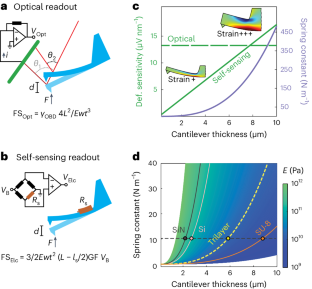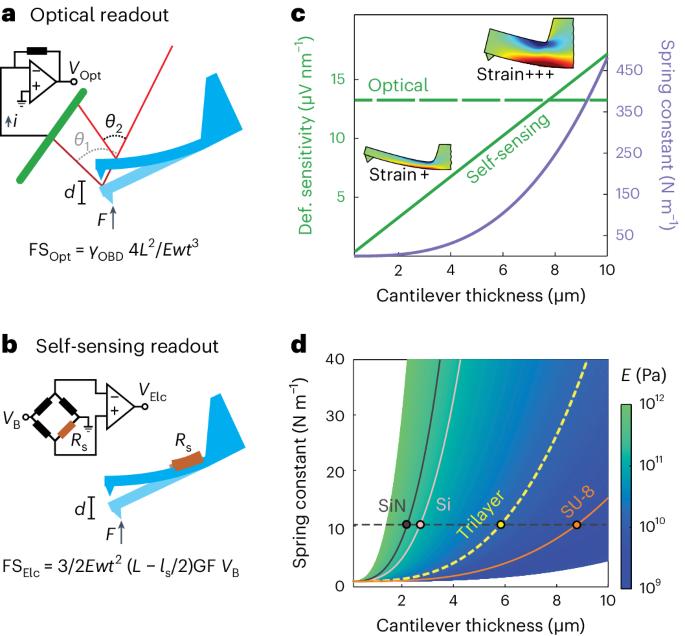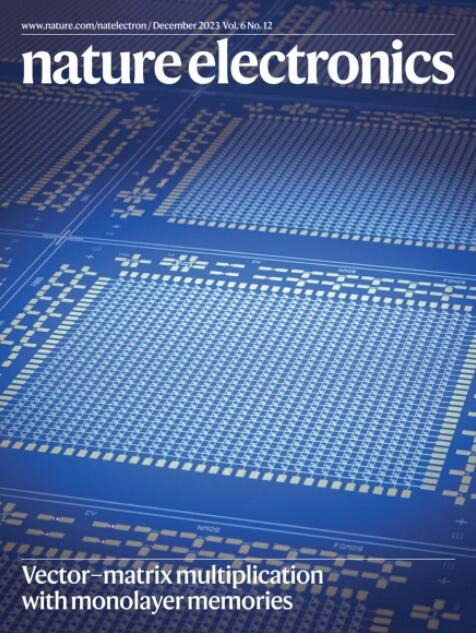A polymer–semiconductor–ceramic cantilever for high-sensitivity fluid-compatible microelectromechanical systems
IF 33.7
1区 工程技术
Q1 ENGINEERING, ELECTRICAL & ELECTRONIC
引用次数: 0
Abstract
Active microelectromechanical systems (MEMS) with integrated electronic sensing and actuation can provide fast and sensitive measurements of force, acceleration and biological analytes. Strain sensors integrated onto MEMS cantilevers are widely used to transduce an applied force to an electrical signal in applications like atomic force microscopy and molecular detection. However, the high Young’s moduli of traditional MEMS materials, such as silicon or silicon nitride, limit the thickness of the devices and, therefore, the deflection sensitivity that can be obtained for a specific spring constant. Here, we show that polymer materials with a low Young’s modulus can be integrated into polymer–semiconductor–ceramic MEMS cantilevers that are thick and soft. We develop a multi-layer fabrication approach so that high-temperature processes can be used for the deposition and doping of piezoresistive semiconductor strain sensors without damaging the polymer layer. Our trilayer cantilever exhibits a sixfold reduction in force noise compared to a comparable self-sensing silicon cantilever. Furthermore, the strain-sensing electronics in our system are embedded between the polymer and ceramic layers, which makes the technology fluid-compatible. By separating high- and low-temperature fabrication processes, cantilevers that incorporate sensing electronics between a soft polymer core and hard ceramic layers can be made, providing high force sensitivity and robustness to harsh environments.


用于高灵敏度流体兼容微机电系统的聚合物-半导体-陶瓷悬臂
集成了电子传感和执行功能的有源微机电系统(MEMS)可对力、加速度和生物分析物进行快速灵敏的测量。在原子力显微镜和分子检测等应用中,集成在 MEMS 悬臂上的应变传感器被广泛用于将外力转换为电信号。然而,硅或氮化硅等传统 MEMS 材料的杨氏模量较高,限制了器件的厚度,因此也限制了特定弹簧常数下的偏转灵敏度。在这里,我们展示了具有低杨氏模量的聚合物材料可以集成到厚而软的聚合物-半导体-陶瓷 MEMS 悬臂中。我们开发了一种多层制造方法,从而可以使用高温工艺沉积和掺杂压阻半导体应变传感器,而不会损坏聚合物层。与同类自感应硅悬臂相比,我们的三层悬臂的力噪声降低了六倍。此外,我们系统中的应变感应电子元件嵌入在聚合物层和陶瓷层之间,这使得该技术与流体兼容。
本文章由计算机程序翻译,如有差异,请以英文原文为准。
求助全文
约1分钟内获得全文
求助全文
来源期刊

Nature Electronics
Engineering-Electrical and Electronic Engineering
CiteScore
47.50
自引率
2.30%
发文量
159
期刊介绍:
Nature Electronics is a comprehensive journal that publishes both fundamental and applied research in the field of electronics. It encompasses a wide range of topics, including the study of new phenomena and devices, the design and construction of electronic circuits, and the practical applications of electronics. In addition, the journal explores the commercial and industrial aspects of electronics research.
The primary focus of Nature Electronics is on the development of technology and its potential impact on society. The journal incorporates the contributions of scientists, engineers, and industry professionals, offering a platform for their research findings. Moreover, Nature Electronics provides insightful commentary, thorough reviews, and analysis of the key issues that shape the field, as well as the technologies that are reshaping society.
Like all journals within the prestigious Nature brand, Nature Electronics upholds the highest standards of quality. It maintains a dedicated team of professional editors and follows a fair and rigorous peer-review process. The journal also ensures impeccable copy-editing and production, enabling swift publication. Additionally, Nature Electronics prides itself on its editorial independence, ensuring unbiased and impartial reporting.
In summary, Nature Electronics is a leading journal that publishes cutting-edge research in electronics. With its multidisciplinary approach and commitment to excellence, the journal serves as a valuable resource for scientists, engineers, and industry professionals seeking to stay at the forefront of advancements in the field.
 求助内容:
求助内容: 应助结果提醒方式:
应助结果提醒方式:


